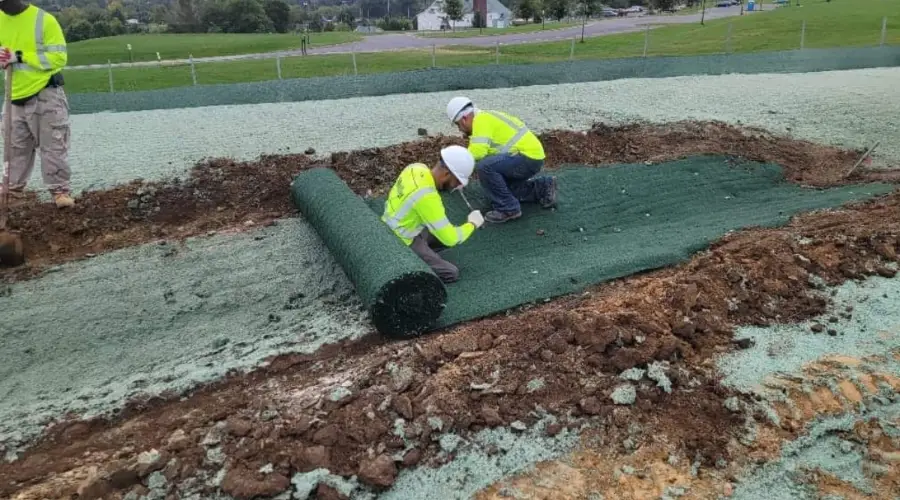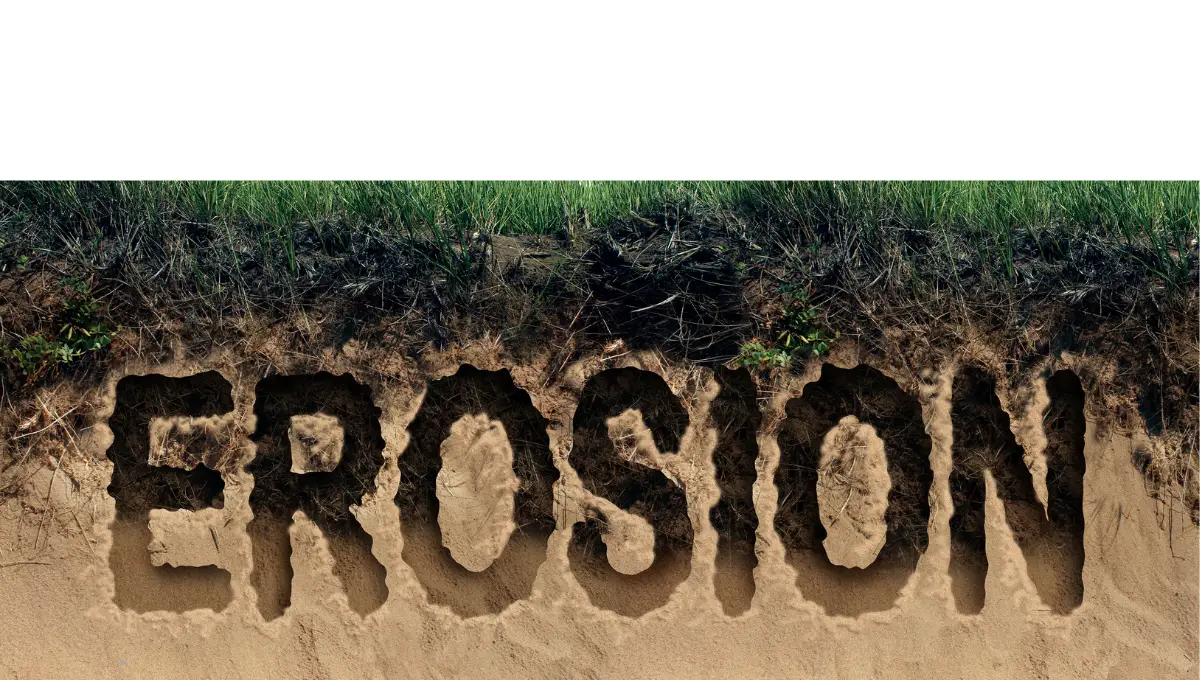One of the key concerns in construction projects is erosion control, as it varies in cause and severity. Each situation requires a tailored solution to protect new structures, preserve construction sites, and minimise environmental impact.
Contractors are continuously innovating with new methods, and manufacturers develop advanced materials to fight erosion. This blog covers erosion control and both common and advanced techniques for effective management of the same on construction sites. Read more to learn about it!
What is Erosion in Construction?
During the construction of any building or structure, soil, rocks, and other materials are moved around because of the activities related to construction. This can also happen naturally through wind or water. Human activities like excavations and gradings may even lead to soil erosion. The debris cleared off the surface is prone to erosion of soil. The increase in soil erosion may result in disturbing the vegetation as well as degrading the soil quality. So, the contractors have to implement some types of erosion preventive measures in favour of the environment and in favour of the constructed structures.
Causes of Erosion on Construction Sites
You must understand why erosion occurs in construction. The factors that contribute to erosion on construction sites include the following:
- Compaction of Soil
Due to the presence of massive machinery and equipment on the construction sites for excavation purposes and other reasons, sometimes soil compaction takes place.
- Removal of Vegetation
Pre-construction work includes clearing the site of debris, including trees, bushes, and grass. This may also cause soil erosion.
- Lack of Erosion Control Measures

Sometimes the failure to implement erosion control measures during construction may also result in erosion.
- Effect of Construction Activities on Water Flow Patterns
Construction activities can change natural water flow patterns. If water is not properly directed, it can accumulate and create areas more susceptible to erosion. This is often seen in urban areas, where improper water management during construction can lead to flooding on construction sites.
- Disruption of the Current Drainage System
Construction may require modifications to existing drainage systems, such as culverts and underground pipes. If these changes are not properly implemented, they can disrupt the current drainage system.
Effects of Erosion on Construction
Construction erosion can have severe effects, even when it just affects the immediate surroundings. Filling and grading are examples of activities that degrade soil quality, cause erosion, and harm the ecosystem.
The following are a few risks associated with erosion from construction sites:
Deterioration of soil quality
In urban areas, the biggest on-site damage is loss of topsoil, caused by wind and water erosion or removal by heavy machinery. The highest levels of organic matter, biological activity, and plant nutrients—all essential elements of healthy soil—are found in this soil layer. The natural capacity of the soil to supply nutrients, control water movement, and fight off pests and disease is all but eliminated when this top layer of soil is lost on-site.
To control landslides, slope-retaining construction is being done.
Water Contamination
Construction-related erosion has an impact on and off-site. Erosion leads to two forms of water pollution: sediment and nutrients that are harmful to aquatic systems.
A surplus of nutrients, such as phosphorus and nitrogen, can cause eutrophication. When these nutrients lead to excessive plant growth, the ecosystem’s equilibrium is upset.
Water that is opaque or turbid due to sediment discharge is unable to receive sunlight. Plant growth is harmed by this decrease in photosynthesis. Fish, plants, and other aquatic life are impacted when photosynthesis is reduced because it lowers oxygen levels.
Strategies for Erosion Control
On building projects, effective site management and planning are essential to stopping soil erosion. Effective design preserves the environment, minimises soil disturbance, and maintains natural water flow. Construction teams can reduce the danger of erosion and practice responsible construction by taking these actions. Here are some key steps to consider:
Site Analysis: Pay close attention to the site’s features such as the soil, landform, and water movement. This directs planning and aids in identifying erosion hazards.
Maintaining Natural Features: When possible, preserve existing vegetation, trees, and natural drainage systems. These characteristics support soil stabilisation and ecosystem maintenance.
Reduce Disturbance: Carefully consider construction plans to prevent causing harm to delicate places, such as steep slopes or wetlands. This lessens the amount of grading and excavation that can cause erosion.
Design for Appropriate Drainage: Configure the area to preserve the water’s natural flow. Create spaces like swales to filter and slow down water, reducing erosion.
Erosion Control During Breaks: To avoid soil damage from wind or rain, employ erosion control techniques even during construction breaks.
Stockpile Management: To stop rain or wind from causing runoff, keep building supplies out of the way of waterways and cover them.
Preserve Vegetation: To safeguard the soil, plant or reseed disturbed areas. For erosion control, use plants with extensive root systems.
Manage Runoff from Stormwater: Utilise stormwater management strategies, such as rain gardens or permeable surfaces, to prevent erosion and maintain pure water in the area.
Frequent Examinations: Make sure erosion control methods are effective by checking them frequently. Resolve any problems as soon as possible to stop soil erosion.
Implementing Erosion Control Measures
Here, we shall examine seven critical concepts on implementing effective erosion control techniques, to provide useful insights that go beyond the basics.
Install Erosion Control Measures
To effectively halt runoff and stabilise the soil, use silt fences, erosion blankets, and sediment barriers right away.
Strategically Plan the Site
With careful site planning, reduce soil disturbance and preserve natural drainage patterns. In order to control water flow and avoid concentrated runoff, proper grading is essential.
Conserve and Restore Plant Life
If at all possible, keep the current vegetation or temporarily remove it while development is underway. To stabilise the soil and stop erosion, replant or reseed disturbed areas as soon as possible.
Maintain Slope Stability
Slopes can be secured with geotextiles, matting, or erosion control blankets. Incorporate plants with deep roots to offer stability and prevent soil movement.
Maintain Drainage Systems
Drainage systems should be routinely inspected and maintained to avoid erosion and water accumulation. Make sure there are no obstacles in any of the drains or culverts.
Reduce the Compaction of Soil
To lessen soil compaction and increase permeability, use heavy machinery sparingly and choose low-ground-pressure equipment.
Advanced Erosion Control Techniques
Some advanced erosion control techniques can be used by construction teams to prevent soil erosion effectively as follows:
Turbidity Barriers
Turbidity barriers shield water sources from pollution and aid in halting soil erosion. They consist of a water-resistant fabric curtain and a flotation boom and are constructed from floating geotextile membranes that are secured with weights. These simple-to-use barriers, also known as floating turbidity silt curtains, aid in sediment containment during construction.
French Drains
French drains direct surface and groundwater to exit points via perforated subterranean pipes. These devices divert excess water while allowing it to sink into the soil. Appropriate drainage is guaranteed by a small slope of 1 inch every 10 feet. Project management software increases installation efficiency.
Mechanically Stabilised Earth (MSE) Walls
With alternating soil and reinforcement material layers, MSE walls are sophisticated retaining walls. They are a popular option for tall structures because of their advantages, which include high load capacity, flexibility, seismic resistance, and faster installation.
Articulated Concrete Blocks (ACBs)
Interlocking concrete blocks create ACBs, which include erosion-resistant systems. These blocks create protective coverings for places like boat ramps and drainage ditches that are vulnerable to erosion. They are adaptable to different terrains and long-lasting.
Geotextiles
Geotextiles stop erosion and increase soil stability. Before building roads, pipelines, or embankments, these textiles are utilised. They are also useful tools for soil reinforcement since they help with drainage, filtration, and separation.
Soil Nails
Soil nails are steel bars inserted into the ground to stabilise slopes and prevent erosion. To give the appearance of a retaining wall, they are capped at the surface. This easy-to-install technique works well on difficult terrain.
Techniques for Dust Control
Dust control is crucial in areas prone to air and water pollution. To control dust and reduce wind erosion, the use of silt barriers, misted water, and polymer additives is practiced.
Riprap
In order to stop soil erosion on slopes or unstable locations, riprap entails piling big stones. This technique works well for safeguarding lakeshores and riverbeds and is frequently used in combination with geotextiles.
Inflatable Dams
An affordable substitute for earthen dams and sandbags is inflatable water dams. They provide superior water control and are simple to install, adapting to site boundaries.
Conclusion
As it can negatively impact the environment and other ecosystems, soil erosion is a major concern on building sites. However, construction teams can reduce the danger of soil erosion and encourage responsible construction practices by putting in place efficient prevention and mitigation measures.

